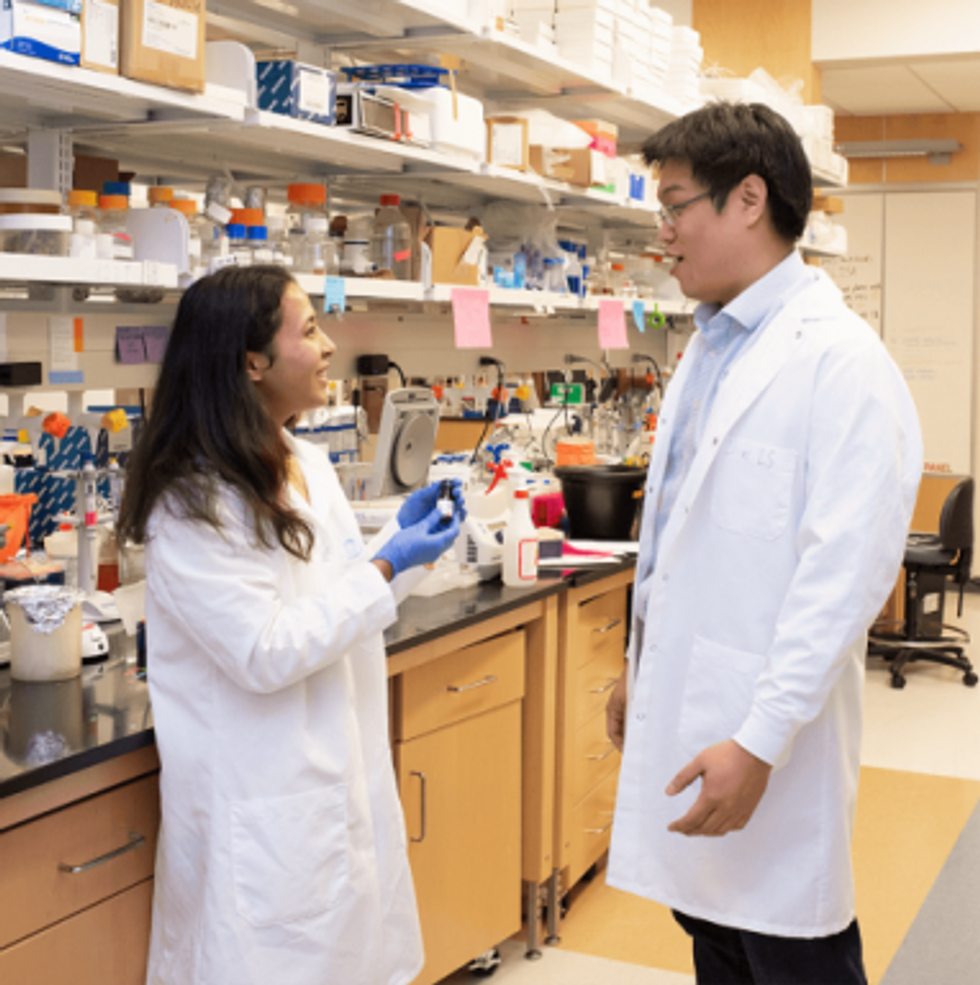Forcing Vaccination on Every Child Undermines Civil Liberties

The author's son Chris, at two years old in the summer of 1980, before his 4th DPT shot.
[Editor's Note: This opinion essay is in response to our current Big Question, which we posed to experts with different viewpoints: "Where should society draw the line between requiring vaccinations for children and allowing parental freedom of choice?"]
Our children are the future. The survival of humanity is advanced by the biological imperative that mothers and fathers want and need to protect their children and other children from being harmed for any reason.
Science is not perfect, doctors are not infallible, and medical interventions come with risks.
In the 21st century, consensus science considers vaccination to be one of the greatest inventions in the history of medicine and the greatest achievement of public health programs. The national vaccination rate for U.S. kindergarten children is 94 percent and most children today receive 69 doses of 16 federally recommended vaccines. However, public health is not simply measured by high vaccination rates and absence of infectious disease, which is evidenced by the chronic inflammatory disease and disability epidemic threatening to bankrupt the U.S. health care system.
Science is not perfect, doctors are not infallible, and medical interventions come with risks, which is why parents have the power to exercise informed consent to medical risk taking on behalf of their minor children.
As a young mother, I learned that vaccine risks are 100 percent for some children because, while we are all born equal under the law, we are not born all the same. Each one of us enters this world with different genes, a unique microbiome and epigenetic influences that affect how we respond to the environments in which we live. We do not all respond the same way to infectious diseases or to pharmaceutical products like vaccines.
Few parents were aware of vaccine side effects in 1980, when my bright, healthy two-and-a-half year-old son, Chris, suffered a convulsion, collapse, and state of unconsciousness (encephalopathy) within hours of his fourth DPT shot, and then regressed physically, mentally and emotionally and became a totally different child. Chris was eventually diagnosed with multiple learning disabilities and confined to a special education classroom throughout his public school education, but he and I both know his vaccine reaction could have been much worse. Today, Chris is an independent adult but many survivors of brain injury are not.

Barbara Loe Fisher and her son, Chris, in December 1981 after his fourth DPT shot.
(Courtesy Fisher)
The public conversation about several hundred cases of measles reported in the U.S. this year is focused on whether every parent has a social obligation to vaccinate every child to maintain "community immunity," but vaccine failures are rarely discussed. Emerging science reveals that there are differences in naturally and vaccine acquired immunity, and both vaccinated and unvaccinated children and adults transmit infections, sometimes with few or no symptoms.
Nearly 40 percent of cases reported in the 2015 U.S. measles outbreak occurred in recently vaccinated individuals who developed vaccine reactions that appeared indistinguishable from measles. Outbreaks of pertussis (whooping cough) in highly vaccinated child populations have been traced to waning immunity and evolution of the B. pertussis microbe to evade the vaccines. Influenza vaccine effectiveness was less than 50 percent in 11 of the past 15 flu seasons.
Vaccine policymakers recognize that children with severe combined immune deficiency or those undergoing chemotherapy or organ transplants are at increased risk for complications of infectious diseases and vaccines. However, there is no recognition of the risks to healthy infants and children with unidentified susceptibility to vaccine reactions, including children whose health suddenly deteriorates without explanation after vaccination. Medical care is being denied to children and adults in the U.S. if even one government recommended vaccination is declined, regardless of health or vaccine reaction history.
When parents question the risks and failures of a commercial pharmaceutical product being mandated for every child, the answer is not more force but better science and respect for the informed consent ethic.
The social contract we have with each other when we live in communities, whether we belong to the majority or a minority, is to care about and protect every individual living in the community. One-size-fits-all vaccine policies and laws, which fail to respect biodiversity and force everyone to be treated the same, place an unequal risk burden on a minority of unidentified individuals unable to survive vaccination without being harmed.
A law that requires certain minorities to bear a greater risk of injury or sacrifice their lives in service to the majority is not just or moral.
Between 1991 and 2013, the Institute of Medicine (IOM) published reports documenting that vaccines can cause brain inflammation and other serious reactions, injuries and death. A 2012 IOM report acknowledged that there are genetic, biological, and environmental risk factors that make some individuals more susceptible to adverse responses to vaccines but often doctors cannot identify who they are because of gaps in vaccine science. Congress acknowledged this fact a quarter century earlier in the 1986 National Childhood Vaccine Injury Act, which created a federal vaccine injury compensation program alternative to a lawsuit that has awarded more than $4 billion to vaccine-injured children and adults.
We give up the human right to autonomy and informed consent at our peril, no matter where or in what century we live.
Vaccine manufacturers and administrators have liability protection, yet today almost no health condition qualifies for a medical vaccine exemption under government guidelines. Now, there is a global call by consensus science advocates for elimination of all personal belief vaccine exemptions and censorship of books and public conversations that criticize vaccine safety or government vaccine policy. Some are calling for quarantine of all who refuse vaccinations and criminal prosecution, fines and imprisonment of parents with unvaccinated children, as well as punishment of doctors who depart from government policy.
There is no civil liberty more fundamentally a natural, inalienable right than exercising freedom of thought and conscience when deciding when and for what reason we are willing to risk our life or our child's life. That is why voluntary, informed consent to medical risk-taking has been defined as a human right governing the ethical practice of modern medicine.
In his first Presidential inaugural address, Thomas Jefferson warned:
"All, too, will bear in mind this sacred principle, that though the will of the majority is in all cases to prevail, that will to be rightful must be reasonable; that the minority posses their equal rights, which equal law must protect, and to violate would be oppression."
The seminal 1905 U.S. Supreme Court decision, Jacobson v. Massachusetts, affirmed the constitutional authority of states to enact mandatory smallpox vaccination laws. However, the justices made it clear that implementation of a vaccination law should not become "cruel and inhuman to the last degree." They warned, "All laws, this court has said, should receive a sensible construction. General terms should be so limited in their application as not to lead to injustice, oppression, or an absurd consequence. It will always, therefore, be presumed that the legislature intended exceptions to its language, which would avoid results of this character."
Mothers and fathers, who know and love their children better than anyone else, depend upon sound science and compassionate public health policies to help them protect their own and other children from harm. If individuals susceptible to vaccine injury cannot be reliably identified, the accuracy of vaccine benefit and risk calculations must be reexamined. Yet, consensus science and medicine around vaccination discourages research into the biological mechanisms of vaccine injury and death and identification of individual risk factors to better inform public health policy.
A critic of consensus science, physician and author Michael Crichton said, "Let's be clear: the work of science has nothing whatever to do with consensus. Consensus is the business of politics. Period."
Condoning elimination of civil liberties, including freedom of speech and the right to dissent guaranteed under the First Amendment of the U.S. Constitution, to enforce vaccination creates a slippery slope. Coercion, punishment and censorship will destroy, not instill, public trust in the integrity of medical practice and public health laws.
There are more than a dozen new vaccines being fast tracked to market by industry and governments. Who in society should be given the power to force all children to use every one of them without parental consent regardless of how small or great the risk?
We give up the human right to autonomy and informed consent at our peril, no matter where or in what century we live. Just and compassionate public health laws that protect parental and human rights will include flexible medical, religious and conscientious belief vaccine exemptions to affirm the informed consent ethic and prevent discrimination against vulnerable minorities.
[Editor's Note: Read the opposite viewpoint here.]
The future of non-hormonal birth control: Antibodies can stop sperm in their tracks
Many women want non-hormonal birth control. A 22-year-old's findings were used to launch a company that could, within the decade, bring a new kind of contraceptive to the marketplace.
Unwanted pregnancy can now be added to the list of preventions that antibodies may be fighting in the near future. For decades, really since the 1980s, engineered monoclonal antibodies have been knocking out invading germs — preventing everything from cancer to COVID. Sperm, which have some of the same properties as germs, may be next.
Not only is there an unmet need on the market for alternatives to hormonal contraceptives, the genesis for the original research was personal for the then 22-year-old scientist who led it. Her findings were used to launch a company that could, within the decade, bring a new kind of contraceptive to the marketplace.
The genesis
It’s Suruchi Shrestha’s research — published in Science Translational Medicine in August 2021 and conducted as part of her dissertation while she was a graduate student at the University of North Carolina at Chapel Hill — that could change the future of contraception for many women worldwide. According to a Guttmacher Institute report, in the U.S. alone, there were 46 million sexually active women of reproductive age (15–49) who did not want to get pregnant in 2018. With the overturning of Roe v. Wade last year, Shrestha’s research could, indeed, be life changing for millions of American women and their families.
Now a scientist with NextVivo, Shrestha is not directly involved in the development of the contraceptive that is based on her research. But, back in 2016 when she was going through her own problems with hormonal contraceptives, she “was very personally invested” in her research project, Shrestha says. She was coping with a long list of negative effects from an implanted hormonal IUD. According to the Mayo Clinic, those can include severe pelvic pain, headaches, acute acne, breast tenderness, irregular bleeding and mood swings. After a year, she had the IUD removed, but it took another full year before all the side effects finally subsided; she also watched her sister suffer the “same tribulations” after trying a hormonal IUD, she says.
For contraceptive use either daily or monthly, Shrestha says, “You want the antibody to be very potent and also cheap.” That was her goal when she launched her study.
Shrestha unshelved antibody research that had been sitting idle for decades. It was in the late 80s that scientists in Japan first tried to develop anti-sperm antibodies for contraceptive use. But, 35 years ago, “Antibody production had not been streamlined as it is now, so antibodies were very expensive,” Shrestha explains. So, they shifted away from birth control, opting to focus on developing antibodies for vaccines.
Over the course of the last three decades, different teams of researchers have been working to make the antibody more effective, bringing the cost down, though it’s still expensive, according to Shrestha. For contraceptive use either daily or monthly, she says, “You want the antibody to be very potent and also cheap.” That was her goal when she launched her study.
The problem
The problem with contraceptives for women, Shrestha says, is that all but a few of them are hormone-based or have other negative side effects. In fact, some studies and reports show that millions of women risk unintended pregnancy because of medical contraindications with hormone-based contraceptives or to avoid the risks and side effects. While there are about a dozen contraceptive choices for women, there are two for men: the condom, considered 98% effective if used correctly, and vasectomy, 99% effective. Neither of these choices are hormone-based.
On the non-hormonal side for women, there is the diaphragm which is considered only 87 percent effective. It works better with the addition of spermicides — Nonoxynol-9, or N-9 — however, they are detergents; they not only kill the sperm, they also erode the vaginal epithelium. And, there’s the non-hormonal IUD which is 99% effective. However, the IUD needs to be inserted by a medical professional, and it has a number of negative side effects, including painful cramping at a higher frequency and extremely heavy or “abnormal” and unpredictable menstrual flows.
The hormonal version of the IUD, also considered 99% effective, is the one Shrestha used which caused her two years of pain. Of course, there’s the pill, which needs to be taken daily, and the birth control ring which is worn 24/7. Both cause side effects similar to the other hormonal contraceptives on the market. The ring is considered 93% effective mostly because of user error; the pill is considered 99% effective if taken correctly.
“That’s where we saw this opening or gap for women. We want a safe, non-hormonal contraceptive,” Shrestha says. Compounding the lack of good choices, is poor access to quality sex education and family planning information, according to the non-profit Urban Institute. A focus group survey suggested that the sex education women received “often lacked substance, leaving them feeling unprepared to make smart decisions about their sexual health and safety,” wrote the authors of the Urban Institute report. In fact, nearly half (45%, or 2.8 million) of the pregnancies that occur each year in the US are unintended, reports the Guttmacher Institute. Globally the numbers are similar. According to a new report by the United Nations, each year there are 121 million unintended pregnancies, worldwide.
The science
The early work on antibodies as a contraceptive had been inspired by women with infertility. It turns out that 9 to 12 percent of women who are treated for infertility have antibodies that develop naturally and work against sperm. Shrestha was encouraged that the antibodies were specific to the target — sperm — and therefore “very safe to use in women.” She aimed to make the antibodies more stable, more effective and less expensive so they could be more easily manufactured.
Since antibodies tend to stick to things that you tell them to stick to, the idea was, basically, to engineer antibodies to stick to sperm so they would stop swimming. Shrestha and her colleagues took the binding arm of an antibody that they’d isolated from an infertile woman. Then, targeting a unique surface antigen present on human sperm, they engineered a panel of antibodies with as many as six to 10 binding arms — “almost like tongs with prongs on the tongs, that bind the sperm,” explains Shrestha. “We decided to add those grabbers on top of it, behind it. So it went from having two prongs to almost 10. And the whole goal was to have so many arms binding the sperm that it clumps it” into a “dollop,” explains Shrestha, who earned a patent on her research.

Suruchi Shrestha works in the lab with a colleague. In 2016, her research on antibodies for birth control was inspired by her own experience with side effects from an implanted hormonal IUD.
UNC - Chapel Hill
The sperm stays right where it met the antibody, never reaching the egg for fertilization. Eventually, and naturally, “Our vaginal system will just flush it out,” Shrestha explains.
“She showed in her early studies that [she] definitely got the sperm immotile, so they didn't move. And that was a really promising start,” says Jasmine Edelstein, a scientist with an expertise in antibody engineering who was not involved in this research. Shrestha’s team at UNC reproduced the effect in the sheep, notes Edelstein, who works at the startup Be Biopharma. In fact, Shrestha’s anti-sperm antibodies that caused the sperm to agglutinate, or clump together, were 99.9% effective when delivered topically to the sheep’s reproductive tracts.
The future
Going forward, Shrestha thinks the ideal approach would be delivering the antibodies through a vaginal ring. “We want to use it at the source of the spark,” Shrestha says, as opposed to less direct methods, such as taking a pill. The ring would dissolve after one month, she explains, “and then you get another one.”
Engineered to have a long shelf life, the anti-sperm antibody ring could be purchased without a prescription, and women could insert it themselves, without a doctor. “That's our hope, so that it is accessible,” Shrestha says. “Anybody can just go and grab it and not worry about pregnancy or unintended pregnancy.”
Her patented research has been licensed by several biotech companies for clinical trials. A number of Shrestha’s co-authors, including her lab advisor, Sam Lai, have launched a company, Mucommune, to continue developing the contraceptives based on these antibodies.
And, results from a small clinical trial run by researchers at Boston University Chobanian & Avedisian School of Medicine show that a dissolvable vaginal film with antibodies was safe when tested on healthy women of reproductive age. That same group of researchers last year received a $7.2 million grant from the National Institute of Health for further research on monoclonal antibody-based contraceptives, which have also been shown to block transmission of viruses, like HIV.
“As the costs come down, this becomes a more realistic option potentially for women,” says Edelstein. “The impact could be tremendous.”
This article was first published by Leaps.org in December, 2022. It has been lightly edited with updates for timeliness.
Researchers probe extreme gene therapy for severe alcoholism
When all traditional therapeutic approaches fail for alcohol abuse disorder, a radical gene therapy might be something to try in the future.
Story by Freethink
A single shot — a gene therapy injected into the brain — dramatically reduced alcohol consumption in monkeys that previously drank heavily. If the therapy is safe and effective in people, it might one day be a permanent treatment for alcoholism for people with no other options.
The challenge: Alcohol use disorder (AUD) means a person has trouble controlling their alcohol consumption, even when it is negatively affecting their life, job, or health.
In the U.S., more than 10 percent of people over the age of 12 are estimated to have AUD, and while medications, counseling, or sheer willpower can help some stop drinking, staying sober can be a huge struggle — an estimated 40-60 percent of people relapse at least once.
A team of U.S. researchers suspected that an in-development gene therapy for Parkinson’s disease might work as a dopamine-replenishing treatment for alcoholism, too.
According to the CDC, more than 140,000 Americans are dying each year from alcohol-related causes, and the rate of deaths has been rising for years, especially during the pandemic.
The idea: For occasional drinkers, alcohol causes the brain to release more dopamine, a chemical that makes you feel good. Chronic alcohol use, however, causes the brain to produce, and process, less dopamine, and this persistent dopamine deficit has been linked to alcohol relapse.
There is currently no way to reverse the changes in the brain brought about by AUD, but a team of U.S. researchers suspected that an in-development gene therapy for Parkinson’s disease might work as a dopamine-replenishing treatment for alcoholism, too.
To find out, they tested it in heavy-drinking monkeys — and the animals’ alcohol consumption dropped by 90% over the course of a year.
How it works: The treatment centers on the protein GDNF (“glial cell line-derived neurotrophic factor”), which supports the survival of certain neurons, including ones linked to dopamine.
For the new study, a harmless virus was used to deliver the gene that codes for GDNF into the brains of four monkeys that, when they had the option, drank heavily — the amount of ethanol-infused water they consumed would be equivalent to a person having nine drinks per day.
“We targeted the cell bodies that produce dopamine with this gene to increase dopamine synthesis, thereby replenishing or restoring what chronic drinking has taken away,” said co-lead researcher Kathleen Grant.
To serve as controls, another four heavy-drinking monkeys underwent the same procedure, but with a saline solution delivered instead of the gene therapy.
The results: All of the monkeys had their access to alcohol removed for two months following the surgery. When it was then reintroduced for four weeks, the heavy drinkers consumed 50 percent less compared to the control group.
When the researchers examined the monkeys’ brains at the end of the study, they were able to confirm that dopamine levels had been replenished in the treated animals, but remained low in the controls.
The researchers then took the alcohol away for another four weeks, before giving it back for four. They repeated this cycle for a year, and by the end of it, the treated monkeys’ consumption had fallen by more than 90 percent compared to the controls.
“Drinking went down to almost zero,” said Grant. “For months on end, these animals would choose to drink water and just avoid drinking alcohol altogether. They decreased their drinking to the point that it was so low we didn’t record a blood-alcohol level.”
When the researchers examined the monkeys’ brains at the end of the study, they were able to confirm that dopamine levels had been replenished in the treated animals, but remained low in the controls.
Looking ahead: Dopamine is involved in a lot more than addiction, so more research is needed to not only see if the results translate to people but whether the gene therapy leads to any unwanted changes to mood or behavior.
Because the therapy requires invasive brain surgery and is likely irreversible, it’s unlikely to ever become a common treatment for alcoholism — but it could one day be the only thing standing between people with severe AUD and death.
“[The treatment] would be most appropriate for people who have already shown that all our normal therapeutic approaches do not work for them,” said Grant. “They are likely to create severe harm or kill themselves or others due to their drinking.”
This article originally appeared on Freethink, home of the brightest minds and biggest ideas of all time.


